Top News
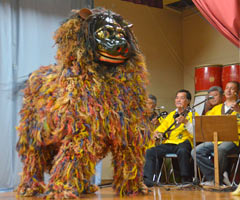
February 26, 2014 Ryukyu Shimpo
The Jitchaku Lion Dance Preservation Society celebrated its 40th anniversary at a community center in Urasoe City on February 23. This shishi-mai lion dance marked the 40th anniversary of it being designated as a National Important Intangible Folk-Cultural Property. The society received the Award for Cultural Merit from the Okinawa Prefectural Government in 2013. The members of the society performed the heroic shishi-mai accompanied by the sanshin and gong, attracting people in the community. The children from the Jitchaku Nursery School performed shishi-mai. Local children performed traditional drama. The members of the society gave a powerful performance of Hoyjeanmae to pray for a good crop of grain and for good health of people in the community. The audience applauded enthusiastically.
Zenko Gushiken, the president of the Preservation Society said, “The Jitchaku Lion Dance Preservation Society was set up after the Battle of Okinawa. Originally its aim was to cheer people up. We will continue to preserve the lion dance that is said to date back about 400 years or more.” Kunihiko Yogi, 16, and Masato Toma, 25, who performed the Hoyjeanmae, were very proud of the fact that they could perform in the 40th anniversary, which is a milestone. They said they would like to learn from their seniors to improve their performance.
(English translation by T&CT)
Go to Japanese
February 21, 2014 Ryukyu Shimpo
Hong Kong Airlines will increase its round-trip flights from Hong Kong to Naha from mid-March. It will operate two round-trip flights a day. The company is aiming to expand its business by attracting tourists not only from Hong Kong but also from China and Southeast Asia via Hong Kong.
Currently, the airlines use an aircraft with 283 seats. It will add another aircraft with 174 seats between March 19 and 29 during the winter schedule.
The airlines introduced the current aircraft to fit in with the increasing number of tourists to Okinawa last April. Two years ago, a larger aircraft was used only during the summer season. However, the airlines have used this aircraft since last year because of good demand.
(English translation by T&CT, Hitomi Shinzato)
Go to Japanese

February 22, 2014 Ryukyu Shimpo
The Okinawa Hands-On NPO has won the Grand Prix and Minister of Education, Culture, Sports, Science and Technology Award of the 7th Child-Support Program for the future sponsored by the Sumitomo Life Insurance Company. This Okinawa City-based NPO works to convey Okinawan traditional culture to the next generation through a picture-story show in the Shimakutuba dialect spoken in the islands. It also has a radio program on the topic of the history and culture of Okinawa.
“It is thanks to the people who love Shimakutuba,” Tatsuya Agena, the director of the NPO, said with pleasure. Ayaka Kamimura, a first grade student of Koza High School, said, “We are happy to be honored with this award because we have been working hard.”
(English translation by T&CT)
Go to Japanese
February 21, 2014 Ryukyu Shimpo
On February 20, the Okinawa Prefectural Government announced the number of tourists who came to Okinawa in January 2014. The number was 495,100, a new monthly record. This represents a 15.2 percent increase over the same period the previous year. The number of tourists who came to Okinawa has exceeded the previous year’s records for 16 consecutive months since October 2012. In addition to New Year’s holidays which were longer than usual, the travel demand over the Chinese New Year was high, which raised the total number.
The number of foreign tourists increased by 3.08 times to 48,100. The total number of foreign tourists from April 2013 to January 2014 was 534,200. This is the first time that the number has exceeded 500,000 in a fiscal year.
The total number of domestic tourists visiting Okinawa increased by 7.9 percent to 447,000. Those from Tokyo increased by 9.9 percent to 226,700, from Kansai by 13.7 percent to 81,400, and from Fukuoka by 4.2 percent to 55,200. However, the number of tourists from Nagoya decreased by 3.0 percent to 35,700.
The number of the tourists from Korea increased by 89.9 percent to 15,000. This is the first time this number has exceeded a monthly figure of 10,000. Those from mainland China increased by 23 times to 11,500, rebounding from the impact of the Senkaku Islands dispute of the previous year. Those from Taiwan increased by 2.7 times to 11,200 with 5,200 tourists from Hong Kong, a 2.8 times increase.
A spokesperson for the Okinawa Prefectural Government said, “Other flights are coming in from Taiwan and Korea this February, so the travel demand to Okinawa will continue to be high and will shift to a higher level than the previous year.”
(English translation by T&CT, Lima Tokumori)
Go to Japanese
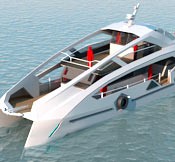
February 23, 2014 Ryukyu Shimpo
On February 14, Vibe Inc., an affiliate company of Bandai Namco Holdings, announced that it will co-develop an electric-propulsion ship with Kuniken Ltd., and the Shin-Itoman Ship Yard Co. The companies plan to complete building the ship this October. They aim to use it as a marine leisure ship in the waters around Ishigaki Island from next spring. According to Vibe Inc., this is the first time that an electric-propulsion ocean-going vessel will be developed in Japan.
The ship will use a lithium-ion battery. The companies plan to build a photovoltaic power supply system on land and use the ship out of the Ishigaki Port Terminal. The system can temporarily provide electrical power to the ship when disaster strikes. The ship’s speed will be eight knots, the same as a diving support vessel.
The ship navigates for two to three hours on one charge. The companies will use it in the sea between Ishigaki Island and Taketomi Island and in the Okinawa Sekisei Lagoon. The 19.5-meter-long ship will weigh 19 tons. It is a catamaran made of aluminum alloy. Part of the ship’s bottom is armored glass, which enables people to see coral from inside the ship.
The companies invested about 60 million yen to develop the ship. They used subsidies for promoting energy base technologies in subtropical islands. The committee, on which Ishigaki City is represented, plans to select the companies to manage the project. Yoshihiko Yamada, a professor at Tokai University, who is an adviser for the project, said, “It is important to use an electric-propulsion ship that is a clean energy vehicle, in the area that will be designated as a World Heritage Site. We would like the ship to be a symbol of Ishigaki.”
(English translation by T&CT)
Go to Japanese
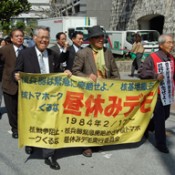
February 22, 2014 Ryukyu Shimpo
The “lunch break peace march” commemorated 30 years on February 21. This has been held by a citizen group every Friday to call for the abolition of nuclear weapons and the promotion of peace. On this day, they marched around the Okinawa Prefectural Office to call for Governor Hirokazu Nakaima to resign and to cancel his approval of the Henoko landfill. The Okinawa Prefectural Assembly was looking into the governor’s approval of the landfill based on Article 100 of the Local Autonomy Act.
This lunch break march began on February 17, 1984 in protest against U.S. warships carrying nuclear Tomahawk cruise missiles. February 21 was the 1,565th time. Saneyoshi Furugen, 84, a former member of the House of Representatives who has taken part since the very first march, said, “We would like to continue this to promote peace of the world.”
Go to Japanese
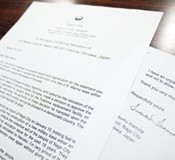
February 22, 2014 Ryukyu Shimpo
On February 21, Nago Mayor Susumu Inamine sent a letter to 29 international intellectuals who released a statement that opposes moving U.S. Marine Corps Air Station Futenma to the Henoko district in Nago. These intellectuals include filmmaker Oliver Stone.
Inamine wrote in the letter that Nago citizens are buoyed by their support for the will of the Okinawan people. He will visit the United States to voice his opposition to Henoko relocation plan before December. Inamime asked the intellectuals to support this move.
The letter is two pages-long and is A4 size written in English. Inamine put his signature on the end of it.
The intellectuals released the statement on January 7. Inamine sent the letter to the initial signers of the statement, including linguist Noam Chomsky and John W. Dower, professor emeritus of history at Massachusetts Institute and Pulitzer Prizewinner. He plans to send letters to another 74 intellectuals, including political scholar Johan Galtung who signed the statement.
In the letter, Inamine severely criticizes Okinawa Governor Hirokazu Nakaima who approved the Henoko landfill. He wrote that the governor trampled on the will of the Okinawan people, something that is unacceptable behavior in a democracy, and that their anger has reached a climax. He went on to say that the Japanese government, which is forcing through the plan despite the reelection of Inamine, ignores the will of the Okinawan people. Inamine stressed the importance of directly voicing opposition in the United States.
(English translation by T&CT)
Go to Japanese
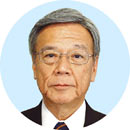
February 19, 2014 Ryukyu Shimpo
Naha Mayor Takeshi Onaga announced his administrative policy for the new fiscal year at a regular meeting of the City Council held on February 18.
Onaga talked about promoting the use of the land returned by the U.S. military. He said, “The Japanese government promotes Okinawa hosting the U.S. military bases. It is important for us to correct the thinking that the Okinawan economy depends on the bases. Beyond ideology, we need to unite the Okinawan people to continue seeking to resolve the base issues.”
Onaga said, “Diplomatic problems complicate base issues.” He continued, “We need to keep in mind that Okinawa aims to promote an independent economy based on peace and security.”
(English translation by T&CT)
Go to Japanese
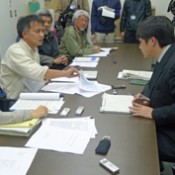
February 9, 2014 Ryukyu Shimpo
Before February 8, the Okinawa Defense Bureau provided the U.S. Marine Corps with the application documents for the Henoko landfill to prepare for moving Futenma Air Station and the environmental impact assessment report. The bureau gave the Marine Corps the full Japanese text and excerpts of the documents in English.
However, the English version does not have charts of the dugongs’ feeding area. Citizens’ groups have questioned this. They claim that the Japanese government did not provide enough information to the U.S. government.
On February 6, the bureau revealed the documents provided to the Marine Corps in the meeting with six citizens’ groups, including the Citizens’ Network for Biodiversity in Okinawa.
The groups asked the bureau how the Japanese and U.S. governments share information on the documents. The bureau explained that they did not receive any questions from the U.S. government after they had provided the documents.
The bureau and the Okinawa Prefectural Government discussed four times on plans to control alien species and protect dugongs last year when the government was examining the application.
The bureau said that they did not tell the U.S. Government about what they discussed with the Okinawa Prefectural Government.
After the meeting with the bureau, Hideki Yoshikawa of the Citizens’ Network for Biodiversity in Okinawa said, “The English translation only provides the text information on the dugongs. It does not contain the dugongs’ feeding areas and migration routes. This is a problem.”
(English translation by T&CT, Lima Tokumori)
Go to Japanese
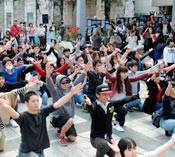
February 12, 2014 Ryukyu Shimpo
On February 11, a gathering, “Listen and tell Okinawa’s voices and thoughts, Ambassador Kennedy” was held in the public square in front of the Okinawa Prefectural Government Office. About 60 young people performed a flash mob with up-tempo music to send the message “Love and Peace.”
Masayuki Chinen, a junior grade student at Okinawa Christian University, said, “I started calling for participants three weeks ago. Young people gathered as individuals, not a group. It gave us a hope that we can do something together.”
They mainly called for participation on Internet sites such as Facebook and practiced for three hours over two days.
Fourteen students from Meio University in Nago took part. Chiharu Takikawa, a junior year student of the university was in charge of dance composition. “I focused on simple and sharp compositions which we could learn in a short time. We were able to create an opportunity to think and act for ourselves through the flash mob,” said she.
(English translation by T&CT, Hitomi Shinzato)
Go to Japanese
February 19, 2014 Ryukyu Shimpo
On February 18, the U.S. military announced the result of testing of soil at the site where an HH-60 rescue helicopter belonging to U.S. Air Force Kadena Air Base crashed in Camp Hansen in Ginoza last August. The lead level in one sample was 0.744 milligrams per liter, 74 times higher than the reference standard of the Japan Ministry of Environment Soil Contamination Countermeasures Law. The arsenic level in one sample was 0.215 milligrams per liter, 21 times higher than the reference standard. It is possible that these substances are residual materials from the aircraft. The Okinawa Prefectural Government and the Ginoza Village Office will investigate the site on and after February 19, when the U.S. military removes the polluted soils. A Ginoza official complained because six months have passed since the accident occurred. “Even if we are given access to the site after removal of the soil we do not know exactly where the helicopter crashed.”
All surface-water samples collected from the Okawa Drinking Water Reservoir and a nearby stream, which are about 70 meters distance from the crash site, were within Japan Environmental Governing Standards limits. The U.S. government concluded that water in the reservoir was safe. The U.S. Air Force collected soil at the crash site between October and December last year and analyzed it using the United States Environmental Protection Agency standard protocols.
Soil removed from the site will be disposed of in accordance with the Japan Environmental Governing Standards, the U.S. military said. The Okinawa Defense Bureau explained to the Ginoza Village officials that the polluted soil would be taken to the United States. The U.S. military will reinvestigate the site and then carry out an aerial hydro seeding to prevent soil erosion. If the Okinawa Prefectural Government requests access to the site, the U.S. military authorities will grant it after removing the polluted soil. The prefectural government had requested to be allowed to investigate the site, but the U.S. military did not grant permission. Prefectural government officials want to carry out the investigation as soon as possible to address concerns of the residents of Ginoza who are under water supply restrictions. Ginoza officials entered the crash site for the first time last December but the military did not allow them to carry out the investigation. They were permitted only to take photographs of the scene. The prefectural government and the village office carried out investigations in the area around the base. They have not detected abnormal values from the samples.
On its website, the Okinawa Defense Bureau has published the results of the assessment prepared by Joe Vogel, Environmental Affairs Branch Head, Marine Corps Installation Pacific.
(English translation by T&CT)
Go to Japanese








 Webcam(Kokusai Street)
Webcam(Kokusai Street)


